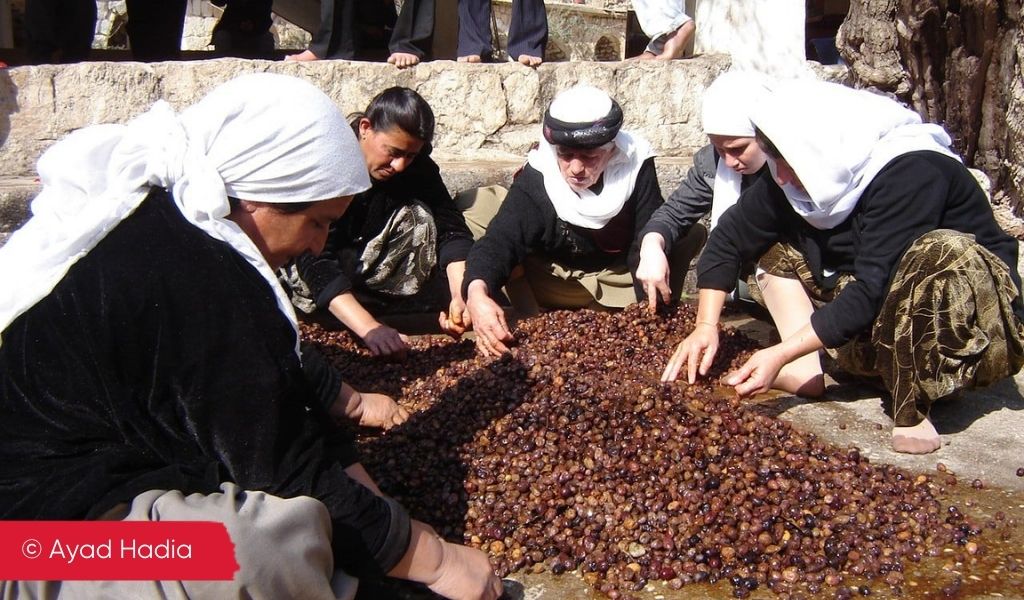In a context were religious minorities and communities are at risk of violent and systematic targeting or climate change impact, the IDS-led Coalition for Religious Equality and Inclusive Development (CREID) programme is working with young people in the Middle East to document and archive their oral heritage. As part of this process, researchers have created a workbook available in Arabic (on request) and English as guide to capturing and storing these “heritage harvests”.

We’ve been working with young people in Egypt, Iraq and Syria to document their oral heritage to preserve for future generations, thanks to initiatives supported by the British Academy and CREID. (Do check out Sofya’s blogs – under Related Content below – on the relationship between heritage and survival, particularly of minorities communities).
Alongside life history interviews and topic interviews covering many aspects of their communities’ heritage, including intangible heritage, a key component of this heritage preservation is how these records will be stored. Thinking about the importance of language and accessibility when it comes to digital archiving practices, we’ve developed a new workbook as a guide to capturing and storing “heritage harvests” (which is what we’ve termed the materials created and collected by the young people consisting of interviews with members of their community, photographs and short films).
This workbook, entitled Preserving Communities’ Heritage: A Workbook for Heritage Capturers, emerged iteratively, drawing on our learning as we implemented these projects and worked alongside young people and communities to document their heritage for future generations. It will be especially useful for those working with marginalised communities at risk of losing important aspects of their cultural practices and identities.
What are “heritage harvests”?
Reconceptualising digital archiving processes as “heritage harvests” enables communities to think through the most contextually relevant steps needed to preserve their heritage under threat due to destruction, displacement and climate change and demonstrates that these practices are not the preserve of experts or archivists. As such, the workbook guides users through the steps to take so that the records of their heritage may be kept safely and securely.
Available in English and Arabic (on request), the workbook is structured into three core sections: (1) Before, (2) During and (3) After Your Heritage Harvests for users to engage with as they go about documenting and preserving their communities’ heritage. This helps communities make a plan that includes doing things before they begin to harvest their heritage crop, whilst they are reaping it, and for how they might create a storage system for their harvest. Their heritage harvest needs to be recorded in a way that is uniform and navigable using programs that are most likely to be compatible with systems for years to come.
Looking after heritage begins the moment you start planning to document it
As we wrote in the workbook itself:
“New technologies and urban migration are changing the way we live. This can be beneficial as it may mean that there are more options available to us with regards to what we want to do with our lives and how we want to live. However, the speed with which these changes are happening means that some of the elements of our lives that we consider important may be lost: for example, the practices that shaped our histories, communities and identities.”
We created “Sara”, a fictional young woman from rural Egypt, who is used throughout the workbook to illustrate some of the challenges and solutions that may be encountered and deployed while documenting community heritage. One way she ensures that practices which were once part of her grandparents’ everyday lives are remembered was to create a heritage harvest.
To create her heritage harvest, Sara did the following:
- interviewed some of the elders in her village about the lives and the events that shaped them
- took photographs and videos of the historical practices and places that are important to her community
- created interview and video recordings related to these events and practices as they specifically occur within her community.
However, the digital documents and files she is collecting are as fragile as the ancient buildings within her village, and can easily be lost or destroyed. Sara learns that because these documents and files are fragile, the heritage they contain is also fragile. As a consequence, it is not enough for Sara to only make these recordings. Rather she needs to think about how they will be stored and looked after so that they can last well into the future. If she preserves these precious documents correctly, then the stories of her community will be known and understood by others for generations to come.
This workbook has been designed to help people and communities like Sara’s so that the stories they have to share will not be lost or forgotten, and ensure the survival of the world’s most at risk communities.